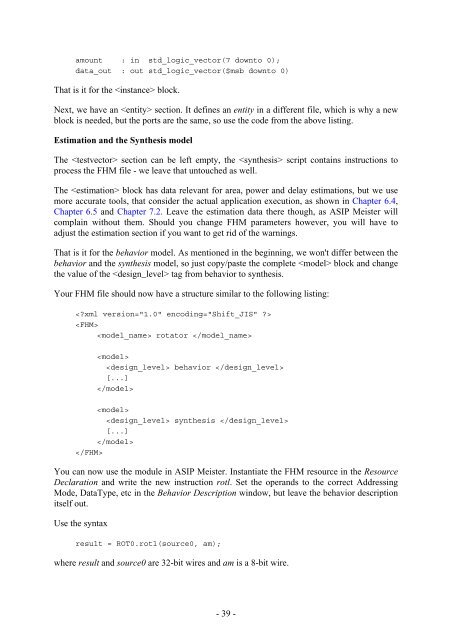Script for Laboratory: Designing embedded ASIPs - CES
Script for Laboratory: Designing embedded ASIPs - CES
Script for Laboratory: Designing embedded ASIPs - CES
You also want an ePaper? Increase the reach of your titles
YUMPU automatically turns print PDFs into web optimized ePapers that Google loves.
amount : in std_logic_vector(7 downto 0);<br />
data_out : out std_logic_vector($msb downto 0)<br />
That is it <strong>for</strong> the block.<br />
Next, we have an section. It defines an entity in a different file, which is why a new<br />
block is needed, but the ports are the same, so use the code from the above listing.<br />
Estimation and the Synthesis model<br />
The section can be left empty, the script contains instructions to<br />
process the FHM file - we leave that untouched as well.<br />
The block has data relevant <strong>for</strong> area, power and delay estimations, but we use<br />
more accurate tools, that consider the actual application execution, as shown in Chapter 6.4,<br />
Chapter 6.5 and Chapter 7.2. Leave the estimation data there though, as ASIP Meister will<br />
complain without them. Should you change FHM parameters however, you will have to<br />
adjust the estimation section if you want to get rid of the warnings.<br />
That is it <strong>for</strong> the behavior model. As mentioned in the beginning, we won't differ between the<br />
behavior and the synthesis model, so just copy/paste the complete block and change<br />
the value of the tag from behavior to synthesis.<br />
Your FHM file should now have a structure similar to the following listing:<br />
<br />
<br />
rotator <br />
<br />
behavior <br />
[...]<br />
<br />
<br />
synthesis <br />
[...]<br />
<br />
<br />
You can now use the module in ASIP Meister. Instantiate the FHM resource in the Resource<br />
Declaration and write the new instruction rotl. Set the operands to the correct Addressing<br />
Mode, DataType, etc in the Behavior Description window, but leave the behavior description<br />
itself out.<br />
Use the syntax<br />
result = ROT0.rotl(source0, am);<br />
where result and source0 are 32-bit wires and am is a 8-bit wire.<br />
- 39 -
















